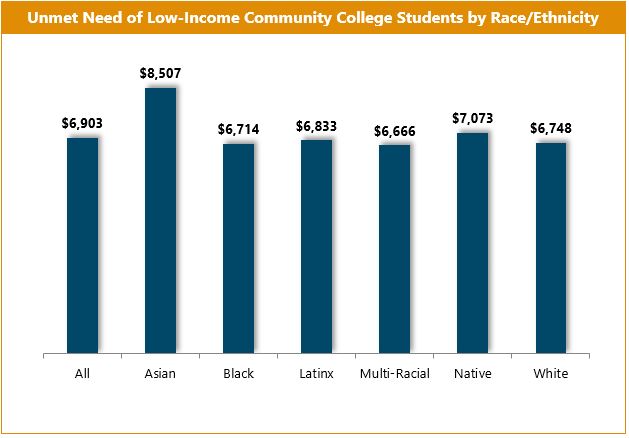Asian-American Students Have Highest Amount of Unmet Need
By Duy Pham
According to recently released data from the U.S. Department of Education, Asian-American students have the greatest amount of unmet need—the gap between the cost of college and what students must pay—among any racial/ethnic group, regardless of income and type of institution attended. This further illuminates how the Asian “model minority” myth is damaging to the success of Asian-American communities and has wide-ranging implications for postsecondary financial aid policies.
The Center for Law and Social Policy’s (CLASP’s) recent paper, When Financial Aid Falls Short, highlights that nearly three in four students experience unmet need. However, students of color have higher levels of unmet need than their white counterparts. At public two-year institutions, 81 percent of Black students, 76 percent of Latinx students, and 72 percent of Asian and Native students have unmet need compared to 66 percent of white students.
However, among all racial/ethnic minorities, Asian-American students have the highest dollar amount of unmet need. For example, Asian-American students in the bottom income quartile (dependent students earning less than $27,900 and independent students earning less than $7,200) have an average unmet need of $8,507. This is significantly higher than the average unmet need of $6,903 among all students in the bottom income quartile. This remains true for Asian-American students across all income quartiles and types of institution.

Disaggregating the data by race and ethnicity reveals significant disparities as well. Poverty rates among Southeast Asian-Americans are greater than the national average. In addition, despite the fact that about half of all Asian Americans have a bachelor’s degree or higher, only 27 percent of Vietnamese Americans, 17 percent of Hmong and Cambodian Americans, 14 percent of Laotian Americans, and 11 percent of Bhutanese Americans have the same level of educational attainment. In comparison, about one third of whites have a bachelor’s degree or higher.
The model minority myth portrays Asian-Americans as a monolithic group that are both academically and professionally successful when compared to other communities of color. A recent, high-profile lawsuit on affirmative action pitting Asian-Americans against each other and against other communities of color demonstrates how damaging this stereotype can be to Asian-American students and workers. While median and average income among Asian-Americans is comparable to whites, income inequality among Asian-Americans is greater than that of any other racial/ethnic group. In other words, the highest-earning Asian-Americans have higher incomes on average than the highest-earning whites; however, low-income Asian-Americans are poorer on average than low-income whites. The poverty rate among Asian-Americans is also greater than whites.
Asian-Americans are also the nation’s fastest-growing population, increasing over 70 percent between 2000 and 2015. This is fueled largely by immigration trends and contributes to the growing income inequality among Asian-Americans. For example, Asian immigrants from 1970 to 1990 were primarily refugees working low-skill occupations, while many recent Asian immigrants have higher levels of educational attainment and benefit from higher-wage jobs under the federal H-1B visa program.
Any number of these factors could be driving the high amount of unmet need among Asian-American students. That’s why we must use disaggregated data to inform the nuanced conversations that’ll help us understand the needs of Asian-American students and how financial aid policies are failing them.
CLASP’s report on unmet need further breaks down the challenges low-income students and students of color face in postsecondary affordability and offers recommendations on improving financial aid policies to meet the needs of today’s students. A key recommendation for states is to center equity and diversity in higher education plans and leverage career pathways to advance racial equity.
